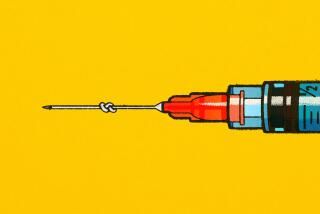SHOP TALK : AHA, a New Wrinkle in Skin-Care Cosmetics : The natural anti-aging product is derived from plants. But a variety of brands, blends and prices can confuse shoppers.
It wasn’t too long ago that the three-letter exclamation AHA was a simple sound indicative of the sudden understanding of a situation. Like, “Aha, that’s where I left my car keys.”
Nowadays, AHA is more complicated,when used as an acronym for alpha hydroxy acids, a popular product in facial care that has been credited with removing wrinkles and slowing the aging of skin.
Sounds wonderful. But AHA may as well be Aaaaaaaah (a term of frustration), considering how many products containing AHAs are on the market and how confusing shopping for them can be.
First, a definition: Alpha hydroxy acids are natural acids extracted from fruits, vegetables and sugar cane that, when applied, loosen up and remove the outer layer of skin where dead skin cells build up, said Pam Rohrbacher, office administrator of Dermatology Associates in Westlake Village. The result, she said, is a smoothing of fine lines, an improvement in skin texture and a reversal of discoloration.
According to Rohrbacher, some experts believe that glycolic acid, derived from sugar cane, is the most effective of the acids at penetrating the skin and getting to work.
But, depending on where you shop for the variety of AHA creams, lotions and gels, you may find the product selling for anywhere from $30 for 1.7 ounces (a Prescriptives brand at Bullock’s department store in Thousand Oaks) to $6.97 for two ounces (a Neoteric Cosmetics Product at Oxnard’s Wal-Mart).
We found a Jason Natural Cosmetics night-time moisturizer at $25 for one ounce, and a Nonie of Beverly Hills all-natural skin cleanser at $10.95 for about seven ounces, both at Lassen’s Health Foods store in Ventura.
At the Ventura K mart, we saw a Maybelline cream for $11.11 for two ounces; a Tri-Alpha Hydroxy Fruit Acid formula cream from Loreal for $10.99 for 1.4 ounces; and a Pond’s brand “age-defying complex” at $10.99 for two ounces.
So why the wide price differences? Well, some of the AHA products contain collagen; others have aloe vera--the whole list of ingredients can vary considerably. And, of course, one would expect to pay more for a name brand at a name store than for a little-known brand at a discount shop.
“But I don’t think the more expensive it is, the better it is necessarily,” said Dr. Ralph Kamell, a Thousand Oaks dermatologist.
The key to effectiveness, with regard to skin-peeling ability, he said, is not the additional ingredients or the name of the cosmetic manufacturer. Rather, it’s the concentration of the alpha hydroxy acids in the product. Some may contain as little as a 2% concentration; others may have 8% or more.
“Eight percent will peel off more skin than 2%,” Kamell said. “The biggest problem is that the cosmetics in department stores don’t always specify on the container the percentage of alpha hydroxy acids in the products. As a result, you may find a 2% glycolic acid selling for more than one with 8%.”
As a rule, Rohrbacher said, you’ll generally find a lower range of concentration of AHA in cosmetics at department stores. “Avon, Clinique, Este Lauder are about 3% to 5% because they want to keep it a cosmetic. If it’s too high a percentage, the FDA will get involved and then the product crosses over into the medical arena, where it could be regulated.”
That’s the commercial end of the situation.
But another way to go with AHAs would be prescription products, the hard stuff. Rohrbacher said most dermatologists tend to start their patients off with an 8% to 10% concentration. “We’ve seen very little adverse sensitivity, or severe types of reactions, at that level,” she said.
Concentrations even go into the 15% to 20% range. Rohrbacher said her dermatology office sells a brand by Therapeutic Products that costs about $20 for eight ounces. The price varies depending on the strength of the product.
Hmmmmmm. (A comment indicating thoughtful consideration of an involved, confusing topic.)






